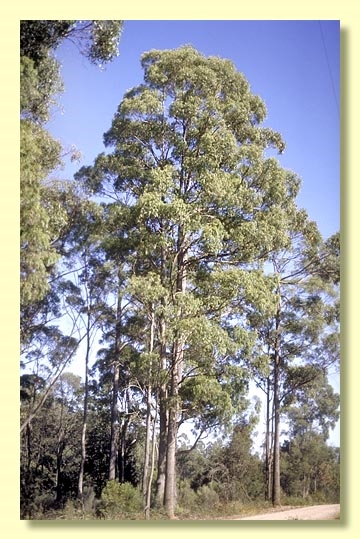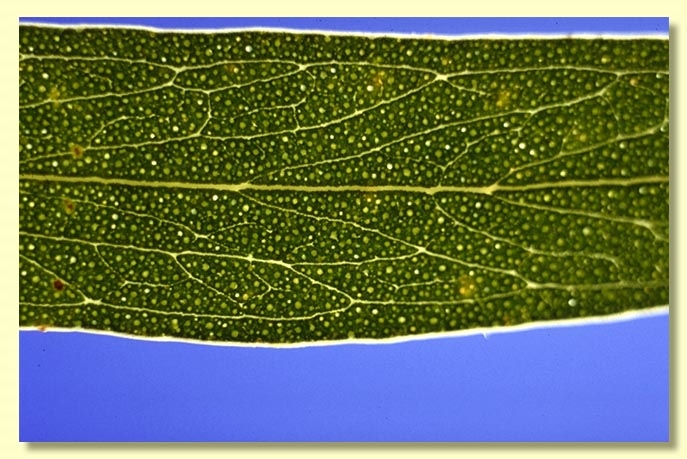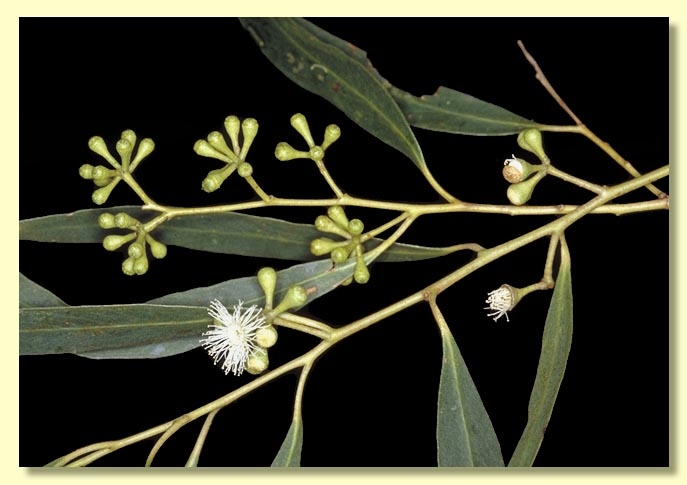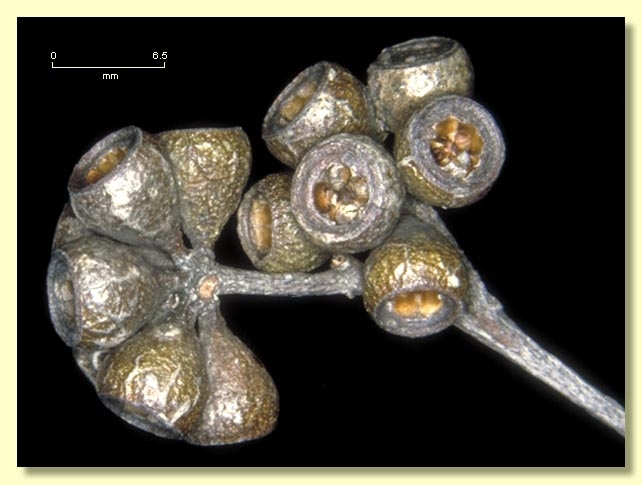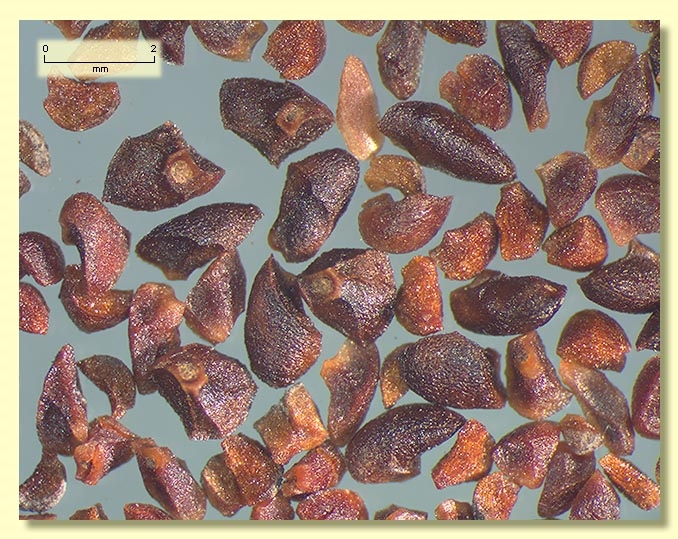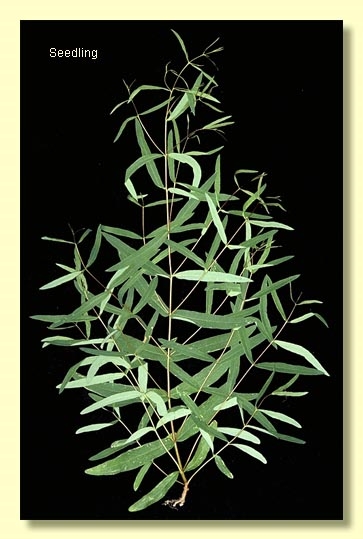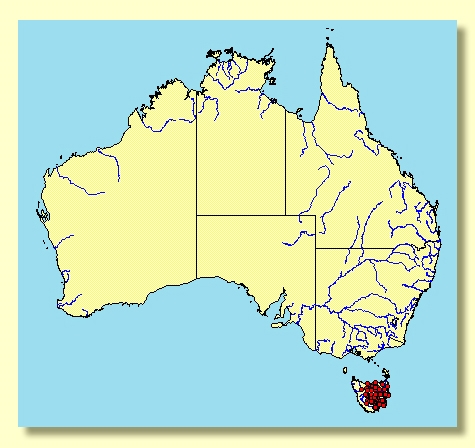Euclid - Online edition
Eucalyptus amygdalina
Eucalyptus | Eucalyptus | Aromatica | Insulanae
Bark rough on part or all of trunk and to base of large branches, finely fibrous peppermint type, dark grey to grey-brown, smooth bark white to grey, or brownish, sometimes with ribbons of decorticated bark held in the upper branches.
Juvenile growth (coppice or field seedlings to 50 cm): stem rounded in cross-section, warty; juvenile leaves opposite for 10 to 15 nodes then alternate, sessile, lanceolate to falcate, 2.8–5.5 cm long, 0.2–1.1 cm wide, margin entire, green.
Adult leaves alternate, petiole 0.4–2 cm long; blade lanceolate to linear or slightly falcate, 5.5–12 cm long, 0.4–1.2 cm wide, base tapering evenly to petiole, margin entire, concolorous, slightly glossy to dull, bluish green maturing green, venation acute to sub-parallel, reticulation sparse to absent, intramarginal vein parallel to and well removed from margin, oil glands few to numerous, island.
Inflorescence axillary unbranched, peduncles 0.4–1 cm long, buds 11 to 15 or more per umbel, pedicels 0.1–0.5 cm long. Mature buds obovoid to clavate, 0.3–0.5 cm long, 0.2–0.3 cm wide, green to yellow, smooth or slightly warty, scar absent although a depression ring may be visible at the join of operculum and hypanthium, operculum rounded to slightly apiculate, stamens inflexed or irregularly flexed, with or without staminodes, anthers reniform to cordate, versatile, dorsifixed, dehiscing by (usually) confluent slits, style short or long, locules 3 or 4, the placentae each with 2 vertical ovule rows. Flowers white.
Fruit sessile or on pedicels 0–0.5 cm long, or sessile, cup-shaped to hemispherical, 0.4–0.7 cm long, 0.4–0.7 cm wide, disc raised slightly or level to descending, valves 3 or 4, near rim level to enclosed.
Seeds brown, 1–2 mm long, pyramidal or obliquely pyramidal to cuboid, dorsal surface smooth, hilum terminal.
Cultivated seedlings (measured at ca node 10): cotyledons reniform; stems rounded in cross-section, warty; leaves sessile and opposite at least 15 nodes, narrowly lanceolate, 3.5–8.5 cm long, 0.3–1.2 cm wide, base amplexicaul to rounded, green to grey-green.
Flowering has been recorded in January, July, November and December.
A small to medium-sized, narrow-leaved peppermint tree endemic to Tasmania, where it is widespread in the drier, north-eastern half of the island, from coastal areas extending well inland to the edges of plateaus.
The bark of Eucalyptus amygdalina is rough over the whole trunk, unlike that in the closely related E. pulchella, which has the narrowest leaves of all the peppermints. The bark in northern forms of E. pulchella may be rough in the lower half of the trunk. The seedling leaves of E. amygdalina are notable for the almost complete lack of oil glands.
Eucalyptus amygdalina belongs to Eucalyptus subgenus Eucalyptus section Aromatica (the peppermints) because the buds have a single operculum, anthers are reniform, ovules are in two rows, seeds are ± pyramidal, adult leaf venation is acute to sub-parallel (rarely parallel) and juvenile leaves are sessile and opposite for many pairs. Within this section, E. amygdalina belongs to an endemic Tasmanian series of 7 species, series Insulanae, with the other species being E. pulchella, mentioned above; E. tenuiramis, a smooth-barked tree with crown of mixed opposite, petiolate intermediate leaves and alternate, petiolate, adult leaves, and connate juvenile leaves on coppice growth; E. risdonii, also smooth-barked but with a glaucous crown of opposite, sessile, often connate juvenile leaves; E. nitida, a rough or partly rough-barked tree species (rarely almost smooth), with a crown of adult, petiolate leaves generally broader than E. amygdalina; and E. coccifera, a smooth-barked species of cold, high areas, with elliptical to cordate (non-connate) juvenile leaves and a crown of fully adult leaves. The 7th species in series Insulanae is the more recently described E. nebulosa, a small smooth-barked tree with grey-blue crown restricted to serpentine ridges north-west of Rosebery; it has narrowly elliptical adult leaves in the crown and sessile short broad elliptical juvenile leaves on coppice growth.
The only other peppermint species found in Tasmania is the more distantly related, common mainland species, E. radiata subsp. radiata, a rough-barked, tall, forest tree restricted, in Tasmania, to the Lemonthyne area. It has a narrow-leaved crown of adult leaves and narrowly lanceolate juvenile leaves with numerous oil glands.

